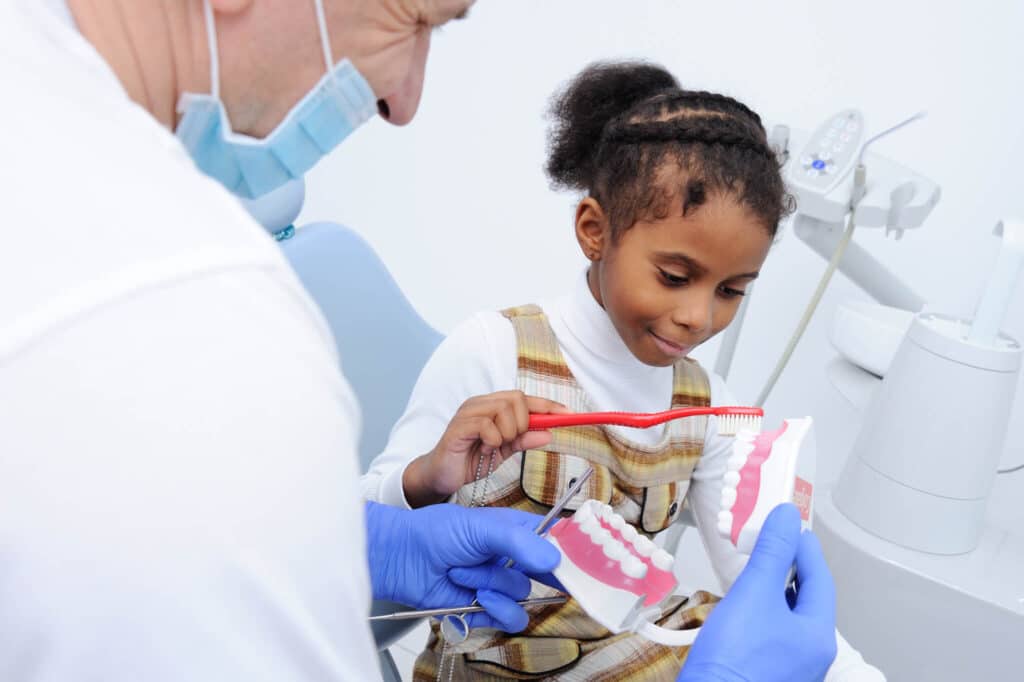When a child loses his or her first baby tooth, it’s time to celebrate! This is a huge developmental milestone, and it means strong, permanent teeth are on the way. If you’re a new parent waiting to fill the Tooth Fairy’s shoes, you may be wondering when do kids start losing teeth? Also, what should you know about the incoming permanent teeth, and what role will the pediatric dentist play in your child’s life?
If your head is spinning with questions, don’t panic—Kangaroo Smiles Pediatric Dentistry has the answers you need on everything related to loose baby teeth. All three of our highly skilled pediatric dental experts can explain the process of losing primary teeth, the eruption of permanent teeth, and everything in between.
Baby Teeth vs. Permanent Teeth
Having two sets of natural teeth in a lifetime can be kind of a strange concept—especially for little ones. In fact, children may express worry or fear when their teeth begin falling out.
Make sure to tell them this is a natural process! Primary teeth are built to fall out, having thinner enamel and shorter roots. Children generally have 20 primary teeth and, after their jaws lengthen as they age, 32 permanent teeth (that includes four wisdom teeth).
But let’s get to the question at hand: when do kids start losing teeth? The American Dental Association’s eruption charts are the best visual guides, providing a range of years in which each tooth erupts and sheds. Here’s a breakdown of these charts:
Central Incisors
Otherwise known as the front teeth, central incisors are commonly the first to come and go. The eruption of these teeth on the bottom row typically takes place between six and 10 months, while the top row central incisors take eight months to a year. Between age six and seven, these teeth are the first to become loose and fall out.
- Lateral Incisors
Lateral incisors take residence next to the central incisors on either side. These baby teeth initially come in between nine and 16 months, depending on the location. By age seven or eight, these teeth are typically gone.
- Canine Teeth
Often identified as the “pointy teeth,” canines arrive between 16 to 22 months in the top row and between 17 to 23 months on the bottom. Between nine and 12 years of age is typically when these primary teeth find themselves vacated and under the pillow!
- Molars
Molars are the top-seeded chewing teeth and are the last to surface. First molars erupt in 13 to 19 months, whereas second molars come in next to them between 21 to 33 months. So don’t worry if you don’t see these babies for a while! Molars also take nine to 12 years to fall out.
With this information in mind, parents often wonder: How vigilant should I be with taking care of my child’s baby teeth if they are just going to fall out? Baby teeth should be treated as meticulously as permanent teeth. Any issues that are not addressed, such as cavities, can still cause serious health issues despite the impermanence of these teeth.
Because of the high sugar content in foods and drinks (even the “healthy” ones) and a lack of knowledge of pediatric dental habits, young children are susceptible to tooth decay. That’s why it’s important to incorporate dental check-ups into your child’s life.
What About Wisdom Teeth?
A set of third molars, or wisdom teeth, will come into the picture between ages 17 and 21. When they form and emerge correctly, wisdom teeth can help you chew. However, if there isn’t enough space for them to surface, wisdom teeth can become impacted and stuck beneath the gumline. This can result in the patient experiencing pain or a build-up of bacteria in that area.
As your child ages, it’s important for the dentist to monitor these kinds of issues. Wisdom teeth extractions are very common and can benefit young patients’ oral health.
Tips for a Healthy Smile
How can new parents keep their child’s mouth healthy, regardless of which developmental stage their teeth are in? Our dental experts and the Kangaroo Krew can provide some great tips.
- Teach Proper Bathroom Habits
With your dentist’s recommendations, you can demonstrate to your child how to brush your teeth, when to spit, and how much toothpaste to use.
- Provide Nutrient-Dense Foods
The less packaged, sugary snacks, the better! These types of carbohydrate-oriented snacks and meals can trigger acid-producing bacteria that eventually lead to cavities.
- Set the Example.
Imagine how awesome it is for children to be able to brush and floss just like Mommy and Daddy! Implementing dental hygiene habits alongside your little one will help him or her feel confident and will ensure they are doing everything correctly.
Do you have more questions related to when kids start losing teeth? Call Kangaroo Smiles at 978-425-1496 today and get the answers you need.


 Central Incisors
Central Incisors